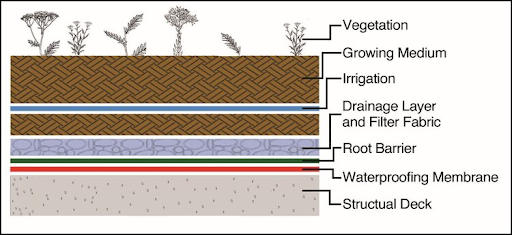Commercial Roofing as a Sustainability Benefit Multiplier
Benefits of Vegetated Roofs
The benefits of vegetated roofs, are too numerous to discuss here. However, how they relate to carbon reduction goals and building resiliency include: waste diversion and extending life of roof membranes, rainwater management, energy efficiency, increased biodiversity, and urban agriculture. First, vegetated roofs can potentially reduce waste to landfill by incorporating recycled materials into the growing medium; while, at the same time extending the useful life of membrane from the roofing membrane by protecting it from expansion/contraction stresses from temperature extremes and ultraviolet light degradation. Second, vegetated roofs can help manage rainwater by storing water in the substrate for the plants to use.
This retention of rainwater helps not only to reduce the volume of water flowing onto impervious surfaces and into the sewer system, but also increase the time it takes to runoff; thereby reducing the strain on aging sewer infrastructure. Third, vegetated roofs provide additional insulation on top of the required code minimum R-value. Fourth, vegetated roofs can provide much needed biodiversity restoration in urban areas, which may also reduce the urban heat island effect. Fifth, vegetated roofs can help reduce the ambient temperature on rooftops, thereby aiding solar arrays to function more efficiently and produce more energy. Lastly, vegetated roofs can provide local agriculture in urban “food deserts.”40 In addition, the emerging practice of agrivoltaics, or agriculture combined with photovoltaics, is showing promise as a symbiotic solution to not only increase the efficiency of solar panels, but also increase crop yields by shading and limiting soil evaporation.41
A report by New York City’s Urban Green Council notes, “Green roofs absorb rainwater and give buildings an extra layer of insulation, which can keep indoor spaces more comfortable, improve energy efficiency and lower carbon footprints. The added vegetation improves local air quality and promotes biodiversity. It also reduces the urban heat island effect, which can raise summer temperatures by up to 22F due to: (1) heat absorbed by building materials and roads; and (2) waste heat from energy use and transit.”42 And, a “50-90 percent reduction in rainwater runoff after installing a green roof.”43
Again, this is not some far off future technology. It is already being done. In fact, on the top of Manhattan’s Javits Center, a 6.75-acre sedum green roof—one of the largest in the U.S.—is now home to 29 bird species, five bat species and thousands of honeybees, and is currently seeing installation of a solar array.44 The “Javits Center opened a one-acre working farm and fruit orchard that should annually yield 40,000 pounds of produce, starting next year.”45
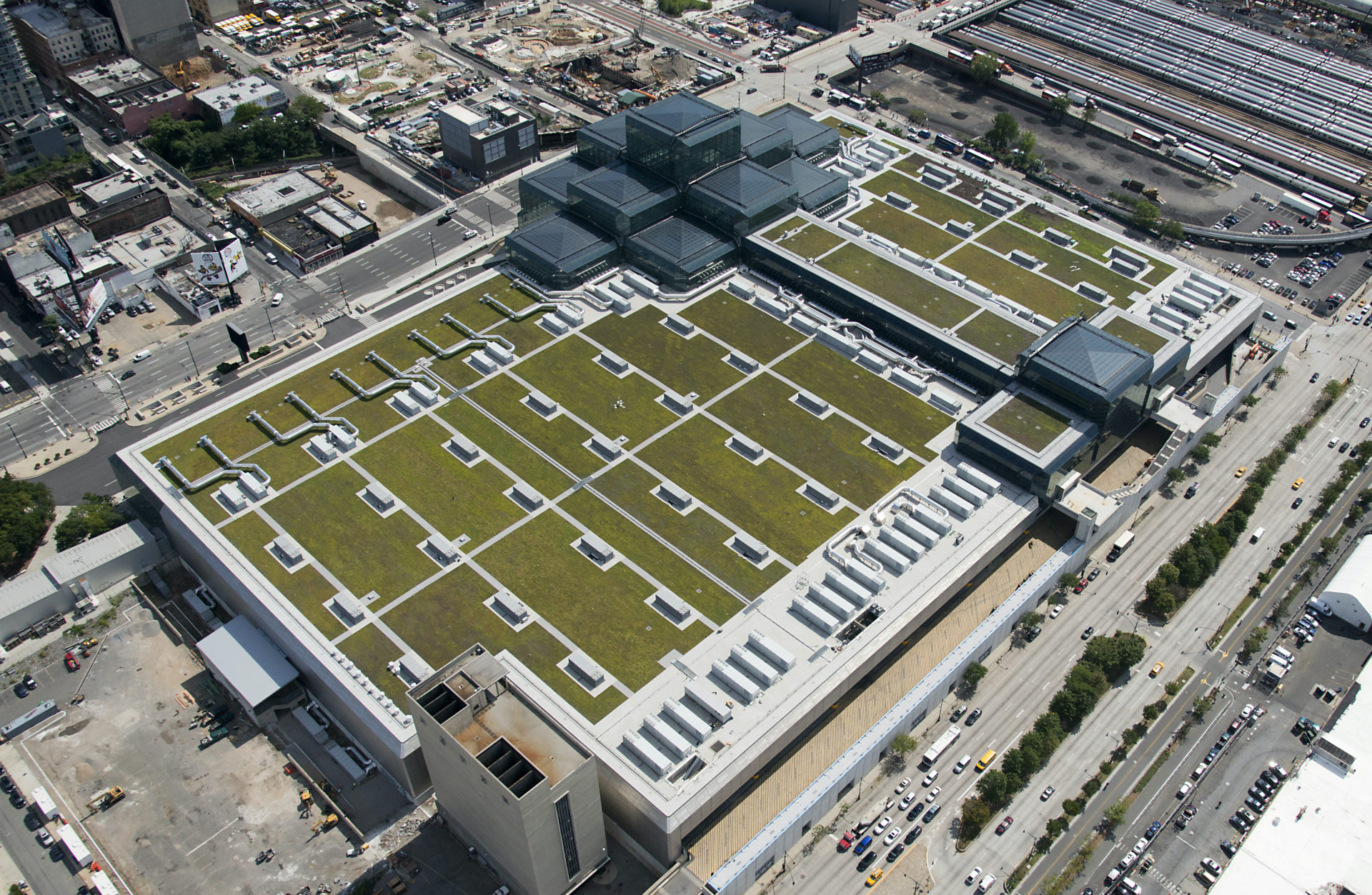
Photo courtesy of Standard Industries
The roof of New York’s Javits Center has a working farm, beekeeping, and is currently installing solar.
Blue, Green-Blue, and Purple Roofs
Beyond urban agriculture and clean energy generation, rooftops are now also improving on the rainwater management capabilities of vegetated roofs with “blue roof,” “blue-green roof,” and “purple roof” advancements. A blue roof is defined as “a roof designed for the retention of rainwater above the waterproofing element of the roof. This is as opposed to more conventional roofs which allow for rainwater to drain from the roof. Blue roofs are typically flat, without any fall, with control devices to regulate drainage outlets that enable water to be retained or drained.”46
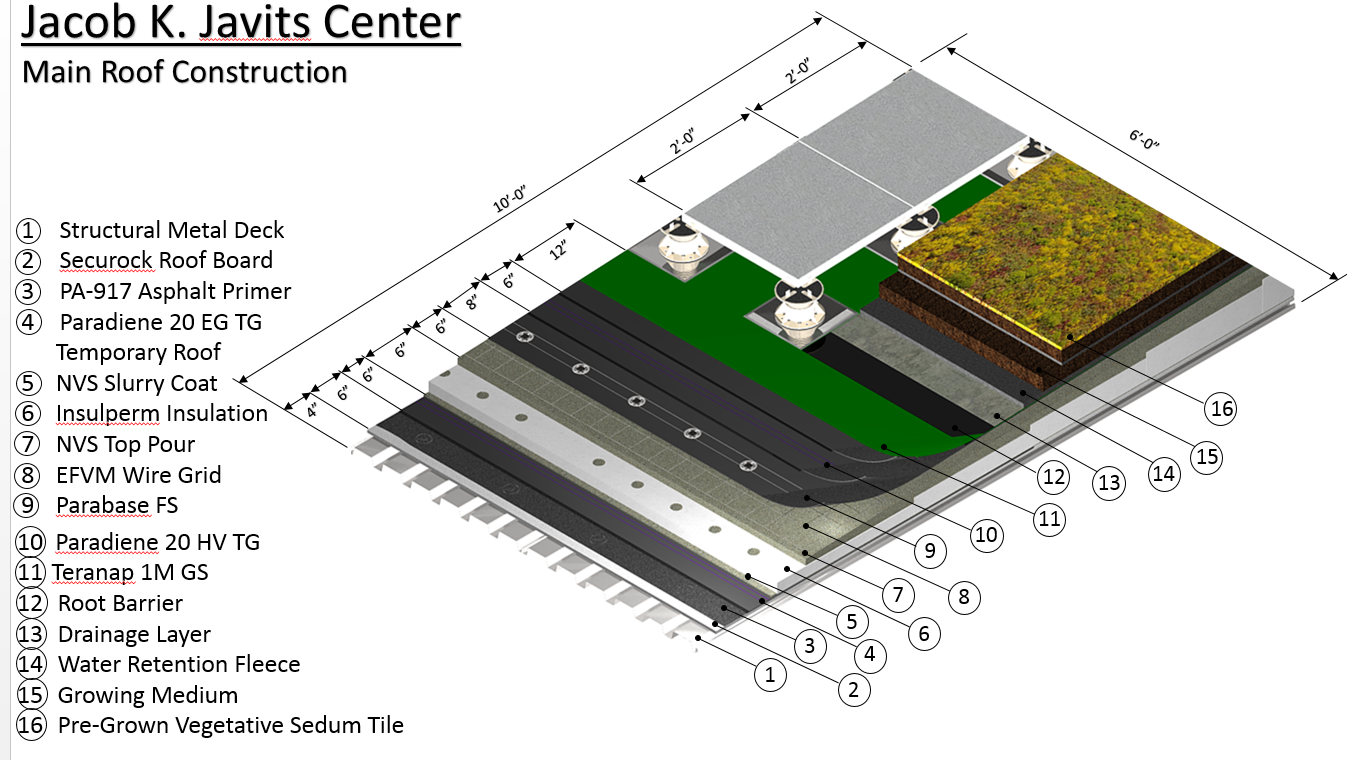
Image courtesy of Siplast
Roof assembly at the Javits Center in Manhattan, N.Y.
A blue-green roof is a blue roof with a vegetated roof assembly, as well. The added vegetation acts as a biological sponge to reduce the amount of rainwater runoff while, at the same time, slowing the rate at which rainwater runs off. Or, in other words, “The blue green roof combines blue and green roof technologies. Conventional green roofs use a drainage layer to provide lateral drainage and irrigation. Blue roof technology, however, aims to increase both the volume of water stored and control the amount of water released. Combining the technologies can increase the overall benefits of greening roof scapes. Therefore, it is not a case of green or blue infrastructure but a blending of the both.47
A purple roof is a blue-green roof that also incorporates a sponge-like layer made of hydrophilic mineral wool to increase the volume of rainwater that can be retained or detained and reduces peak outflow by up to 95 percent.48
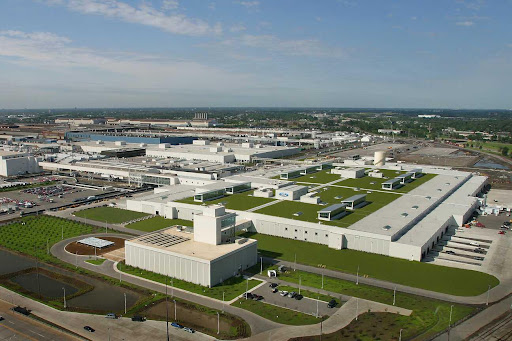
Photo courtesy of Siplast
Ford River Rouge Blue Roof.
Photo courtesy of Semper Green
An example of a purple roof.
Image courtesy of GAF/Siplast Embodied Carbon AIA
Section detail of a vegetated roof.
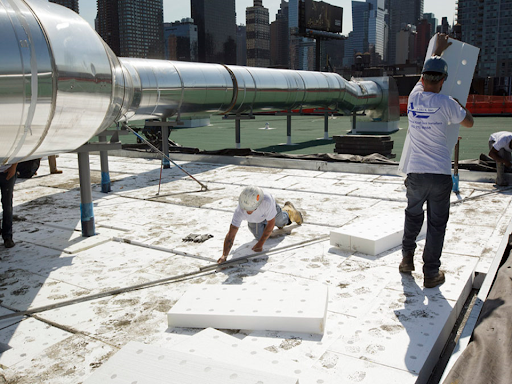
Photo courtesy of Siplast
Installing the Light Weight Insulating Concrete roof on the Javits Center in Manhattan, N.Y. (above & below)
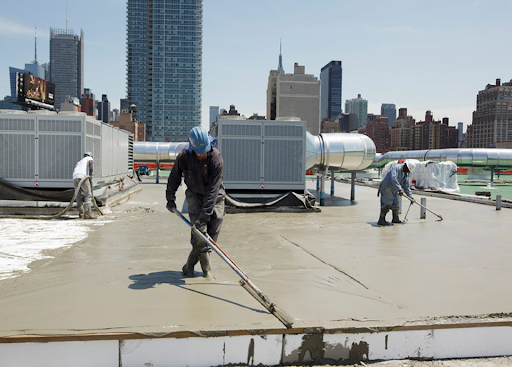
Photo courtesy of Siplast
Conclusion
In summary, carbon is the unifying metric to understand sustainability and resiliency, which are all interconnected and interrelated. A holistic understanding of our building design decisions can only be understood through the lens of whole life carbon analysis. High CO2 levels in the atmosphere are causing us to develop resiliency strategies while reducing carbon in the atmosphere is the solution. It's the chicken AND the egg.
Taking all of this into account, commercial roofing has the unique opportunity as a sustainability benefit multiplier to not only shelter us from increasingly severe weather events, but also allow communities to thrive in the face of climate change, while at the same time addressing the need to reduce carbon emissions in the atmosphere. However, this is no small task. All stakeholders must work together collaboratively if we’re to realize a world where future generations can meet their own needs without compromising the needs of society today.





